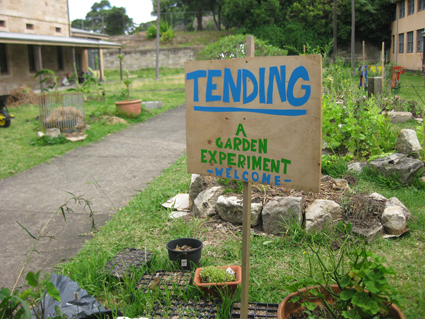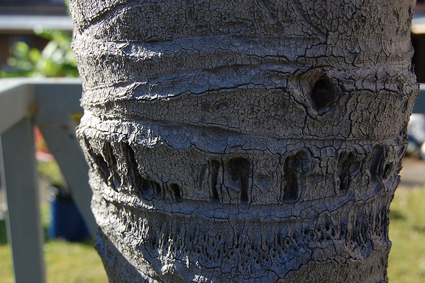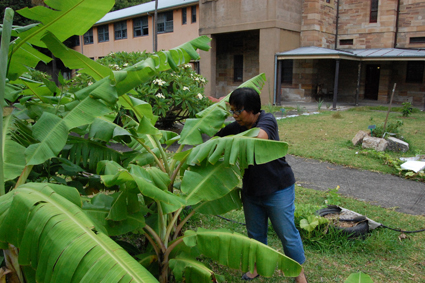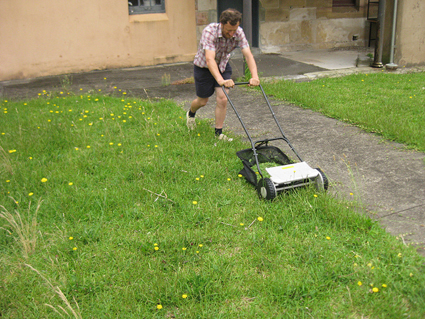 |
Tending: A Garden Experiment photo courtesy of the artists |
how does your garden grow?
Since mid-2010 Lucas Ihlein and Diego Bonetto’s project Tending has gently moved in and things have started to grow, both in the garden and online via their blog. Tending is a kind of artists’ garden experiment that engages with the biological, social, aesthetic and institutional fabric of a small, but not altogether insignificant, place.
The project was conceived in collaboration with Ross Gibson (Professor of Contemporary Arts, SCA) as a potential research focus for staff and students that would work towards materialising the garden theme of the college’s Callan Park location. For Gibson, the significance of the project lies in the way that gardens are “like comprehensible and pleasurable versions of the messy contemporary world—interactive, delicate, hard work, generative, social, beautiful, requiring constant care and co-operation.”
The initial plan, explains Ihlein, was to occupy a piece of land at the entrance of the college and have the garden function as a de facto go-between for the two worlds of “art school” and “rest of the world.” However, bureaucratic and institutional complexities made this difficult and Tending was made to adapt and cooperate with its current, more internal, location in the courtyard next to the SCA library. It is within this context that Ihlein and Bonetto have described Tending as a process that “intervenes, lightly.” Like a newly emergent eco-system Tending has fractured as much as it has fused through soft day to day interventions and co-operation(s)—that have gently pushed at what is possible artistically, institutionally, biologically and socially.
Located in Kirkbride Park, on the historic grounds of Callan Park, in the former-psychiatric-hospital-cum-contemporary-art-school, Tending’s relationship to place is decisive. Callan Park is an environment where the contemporary politics of arts education, mental health and urban land development are forever simmering below the surface of the rolling parklands and iconic architecture that fill 61 hectares of contested real estate on the shores of Sydney Harbour. Quietly, yet ever present, older Indigenous and settler histories embedded in the local area also linger.
 |
W.L. 19-8-44, Tending photo courtesy of the artists |
 |
Betty harvesting some banana leaf, Tending photo courtesy of the artists |
process and products
There is a genuine warmth and unpretentiousness that characterises the project both in person (on site) and via the blog (online). Characters emerge in the unfolding narrative of Tending—characters that can just as easily be plants as people. The blog’s quaint attention to detail begins to feel like a slow meditative reality TV show, whose production team would be carrying around copies of Michel de Certeau’s The Practice of Everyday Life alongside their shovel. Some characters stay longer than others, such as Tending’s switched on VIP Betty whose knowledge has gone deep into that soil, but they all contribute to an interesting balance of contention and co-operation, order and unruliness that sits at the core of Tending as an artwork in process.
But Tending is not an artistic process without products. Indeed, gardens themselves provide ideal places to explore the dynamic between process and product. As Ihlein explains, “one would quickly tire of digging the soil if, season after season, there were no yields.” Some products Ihlein and Bonetto have seen emerging from the collective labours of Tending include: physical pleasure; a clear mind; some lettuces, cucumbers, pumpkins and lots of basil; knowledge about what to plant at different times of the year; new friendships; heated discussions about the definition of art; some small wages; a series of guest lectures; an open-air studio; an improvement in soil quality; a restful place on campus...
 |
Grass, Tending photo courtesy of the artists |
tending the future
The future of Tending is uncertain. The artists are looking into ways of enabling the garden at SCA to continue indefinitely, mapping out a kind of “management hand-over” to students and staff at the college, which the artists have jokingly likened to the process of America pulling out of Iraq. There are also pending grant applications that could potentially see the project extend over to the main campus of Sydney University as part of a new Diabetes and Obesity research facility, whereby gardening-as-art will be put to practical use beyond its current context. In the process we might just see the estrangement that all too often exists between disciplines further collapse.
In his essay, The Emancipated Spectator, Jacques Rancière argues that emancipation is not so much about “activation” over a “passivity” that is perceived to be inherent in spectatorship, but rather about breaking down the very oppositions that inform this kind of hierarchical understanding of things. Rancière concedes that an emancipated community is in fact a community of storytellers and translators. In this sense Tending is producing a community of gardeners that bring worms to the surface of the soil and sprout edible fruits from seeds as much as they uncover over-looked histories, confront artistic norms and forge new relationships with people and place.
Lucas Ihlein and Diego Bonetto, Tending, Sydney College of the Arts, www.tending.net.au
This article was first published in our May 24 e-dition.
Alana Hunt is an artist and writer who acts as a catalyst of culturally charged encounters. Much of her recent work has emerged from the Indian occupied region of Kashmir, focusing on experiences of everyday life under military occupation through intimate, poetic and relevant means. She currently works for Warmun Art in the remote East Kimberly region of Western Australia. www.alanahunt.net
RealTime issue #103 June-July 2011 pg. 4
© Alana Hunt; for permission to reproduce apply to [email protected]








 back
back